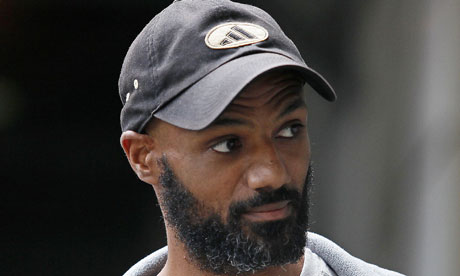Fellow captive Abu Zubaydah was waterboarded until he named British resident as 'dirty bomb' plotter
The Guantánamo Bay files demonstrate how authorities tried to cover up Binyam Mohammed's harsh interrogation in Pakistan and torture in Morocco before he signed a confession under duress. Photograph: Shaun Curry/AFP/Getty Images
Guantánamo's commandant tried to stop the incoming Obama administration returning Binyam Mohamed to Britain, claiming he had "unique information of intelligence value" and had plotted "to inflict mass casualties within the US".
The US military insisted Mohamed was involved in a so-called "dirty bomb" plot. But the authorities cited discredited testimony extracted from a fellow prisoner who had himself been waterboarded.
The leaked reassessment of Binyam Mohamed's case, dated 26 December 2008 and signed by Rear Admiral David Thomas, graphically demonstrates the flimsiness of much of the evidence extracted by CIA interrogators in their secret prisons. Those interrogated were subsequently deposited in
Guantánamo where their confessions were apparently treated as hard fact.
On the basis of this material Thomas said he "recommends this detainee for continued detention … Even if released with rehabilitation, close supervision and means to successfully reintegrate into his society … [he] would probably re-engage in extremist activities … GTMO determines this detainee to be a high risk, as he is likely to pose a threat to US interests and allies."There were two key factors against Mohamed, according to Thomas's report: that he had confessed, and that another inmate, Abu Zubaydah, confirmed his link to a "dirty bomb" plot against America. Both pieces of evidence, it has now been established, were obtained by ill-treatment possibly amounting to torture.
"During an interrogation in 2004 detainee admitted guilt on his part and 'wished to bring his case to a peaceful resolution' which included a signed statement documenting his activities … Detainee admitted his involvement in the H-bomb plot intended to attack the US."
However, according to Mohamed himself, who was released only a few weeks later in February 2009 after UK government intervention, he was at the time of the confession being kept shackled for days on end in a pitch-black CIA cell, systematically deprived of sleep and subjected to 24-hour rock music played at top volume.
It followed brutal torture in cells in Morocco, where his genitals were slashed with a scalpel, he says.
This in turn came after admitted degrading ill-treatment in Pakistan – where he was captured in 2002 – that took place with the complicity of MI5 officers.
The UK court of appeal ruled last year he had been subjected to "cruel, inhuman and degrading treatment by the United States authorities".
Mohamed says his confession was false.
After he made it he was transfered to Guantánamo, on 19 September 2004.
The Guantánamo "detainee assessment" report claims details of Mohamed's involvement in the dirty bomb plot were confirmed by another inmate. But it discloses his identity: Abu Zubaydah, a Palestinian who it is now admitted was waterboarded – a near-drowning experience – in another secret prison by CIA interrogators to make him implicate others. Zubaydah's prisoner number is GZ-10016.
"GZ-10016 stated detainee and US-10008 presented the idea to him of constructing a nuclear dirty bomb for an attack against the US. GZ-10016 reported detainee stated he could make the dirty bomb work and expressed his willingness to become a martyr.
" US-1008 is José Padilla, who was subsequently arrested entering the US and eventually convicted on other charges of aiding terrorism but never faced charges relating to the dirty bomb claims.
As well as citing Zubaydah's post-waterboarding statements to interrogators, the files claim that Mohamed downloaded instructions on how to build an "H-bomb" from the internet. But it has emerged since Mohamed's release that the material he viewed was a spoof article by a US satirical magazine.

